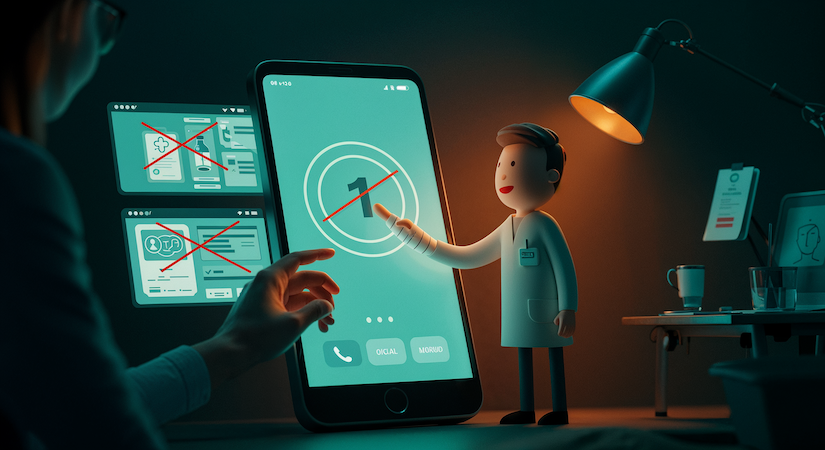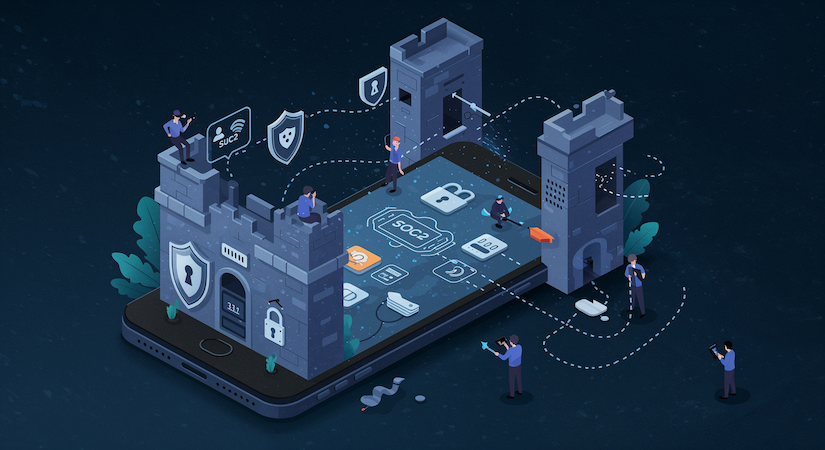If post-op care were a movie, it would be less Grey’s Anatomy and more Groundhog Day—same tasks, different patients, and a high chance of something slipping through the cracks if you blink.
Clinician-founders and digital health teams already know this: building a tool that truly supports patients and lightens provider load is anything but plug-and-play. This blog unpacks the real-world challenges—from adherence black holes and device quirks to AI integration and HIPAA landmines—and walks you through how successful apps actually handle them.
You’ll leave with a sharper sense of what works (and what quietly kills engagement, compliance, and adoption)—and a clearer idea of how to build something that actually delivers for post-op recovery.
Key Takeaways
- Real impact starts after the download. Successful apps don’t just remind—they drive measurable improvements in readmissions, adherence, and clinician burnout.
- AI, wearables, and dashboards won’t save you—unless they’re wrapped in human-centered UX and HIPAA-first architecture.
- If your app doesn’t reduce friction for both patients and providers, it won’t scale—no matter how slick your tech is.
Table of Contents
- Key Challenges in Post-Operative Patient Management
- Why Bother? The Real Benefits of Digital Post-Op Care
- Different Types of Post-Op Care Apps
- Best Practices for Engaging Patients Digitally
- Thoughtful AI Integration: Supplement, Don’t Replace
- Navigating Development Challenges in Post-Surgery Apps
- Ensuring Security and Compliance (HIPAA and Beyond)
- Metrics for Success: Beyond Just Downloads
Key Challenges in Post-Operative Patient Management
Post-surgical care isn’t one problem—it’s five or six tangled together. Let’s break them down.

Patient Adherence Is a Leaky Bucket
The moment a patient walks out of the OR, they’re bombarded with instructions: meds, wound care, therapy exercises, follow-up visits. And even if they nod along at discharge, adherence plummets fast—especially if there’s no coach, no reminders, no feedback loop.
- A 2024 perioperative app study showed adherence rates above 75% with push notifications and human coaching.
- But in remote-only physical therapy trials? Adherence dropped by 40% vs in-person rehab.
- Up to 65% of patients fail to stick to post-op routines in the absence of strong digital scaffolding.
Adherence gaps are a top driver of readmissions. So if your app doesn’t offer timely nudges, progress feedback, or escalate when patients ghost their care plan, expect your outcomes to leak too.
Clinical Signal vs Digital Noise
Surgeons don’t need more data. They need cleaner signals. But most digital post-op tools are still slinging raw vitals, vague patient-reported outcomes, or redundant alerts across fragmented systems. Enter: decision fatigue and alert fatigue.
- ICU nurses face 300+ alerts per day. Up to 99% are non-actionable.
- A 2023 TigerConnect survey found 85% of clinicians deal with communication overload regularly.
- Worse, most apps weren’t designed with human-factors tuning—so they trigger alerts like it’s confetti.
The result? Clinicians start tuning out—sometimes even missing the real red flags.
HIPAA Meets DIY: A Compliance Balancing Act
Post-op care tools are PHI magnets. You’re collecting wound images, vital signs, medication logs, mood data, etc.. But trying to move fast with no-code platforms or SaaS widgets that weren’t built for healthcare? That’s how you end up in breach territory.
- Plenty of “remote care” apps route data through third parties with no BAA in sight.
- Many founders still conflate “encrypted” with “compliant”—spoiler: it’s not.
In other words, if your stack includes plug-ins, third-party cloud processors, or mobile SDKs, assume you’ve got compliance exposure until proven otherwise.
Clinician Burnout: The Elephant in Every Exam Room
Digital tools that aren’t designed with clinicians tend to work against them. If your app adds to their inbox, drowns them in alerts, or requires another login, it’s a burnout multiplier.
- Burnout affects ~50% of U.S. physicians and nurses in 2025 .
- Alert fatigue is a key driver—clinicians in the top quartile of electronic message volume are 6x more likely to report burnout .
- Many apps still lack role-based alert routing, which means everyone sees everything (translation: nobody wants to see anything).
Tech Barriers: Not Everyone Has an iPhone (or Wants One)
It’s easy to forget: not every patient is digitally fluent. Many elderly or low-income users struggle with apps, Bluetooth devices, or even SMS codes.
- 25–30% of older adults in one study refused remote monitoring altogether.
- Others needed caregiver help just to operate the app or enter data.
The irony? These are the patients most likely to need close post-op follow-up.
Equity and Access: One Platform ≠ One Outcome
Access to post-op care shouldn’t hinge on a stable Wi-Fi connection or someone’s ZIP code. But digital health still skews toward the digitally literate, urban, and insured.
- Many patients lack reliable internet or a device that can run your app.
- Cognitive or language barriers can make even the cleanest UI feel unusable.
Some programs are now assigning community health workers or nurse navigators to re-engage patients who fall off the digital map.
True scalability means planning for people outside your ideal persona.
Why bother? The Real Benefits of Digital Post-Op Care
If you’re wondering whether it’s worth the hassle to build or fund a digital post-op platform, here’s what the data actually says:

Fewer Readmissions
Telehealth-enabled post-op care has been shown to reduce 30-day readmission rates by up to 75% in real-world U.S. studies. Programs at WakeMed and UPMC saw sharp declines in ER visits and unplanned hospital returns after adding video follow-ups and digital coaching.
Higher Patient Engagement
Apps like Pip Care achieved 80%+ weekly engagement and 6–7 average coaching sessions per patient. That’s not a vanity stat—higher engagement directly correlates with better recovery outcomes and shorter hospital stays (e.g. 1.9 vs 3.0 days).
Also read: A Guide to Improving the Patient Engagement
Better Access and Convenience
Telemedicine removes travel barriers, especially for elderly and rural patients. Patients didn’t ghost their digital follow-ups either—no-show rates were not higher for video visits vs in-person appointments in multiple hospital systems.
High Patient Satisfaction
Digital users reported 4.8/5 satisfaction, and in some studies, over 97% of patients preferred remote recovery support over traditional models . Personalized education, easier check-ins, and family involvement helped boost this love.
Cost-Effective Interventions
Even basic digital setups (video check-ins + reminders) identified issues early enough to allow proactive treatment in 36% of patients, avoiding complications that would’ve cost hospitals far more in ER bills and re-admissions.
In short: when digital post-op care is done right, it doesn’t just improve outcomes—it makes recovery more humane, more predictable, and way less expensive for everyone involved.
Different Types of Post-Op Care Apps
If you’re still thinking “we just need an app to remind patients about meds and PT,” you’re already behind. The post-op care app market has fractured into verticals, micro-verticals, and micro-micro-verticals. And good! Because a bariatric patient doesn’t need the same digital support as someone recovering from ACL surgery or cardiac bypass.

Let’s walk through the real landscape—because your product isn’t just competing with inaction anymore. It’s competing with niche startups that know their lane really well.
Remote Monitoring Apps (RPM & RTM)
The OGs of digital post-op: think vitals, wound photos, and symptom tracking. But now we’ve got RTM (Remote Therapeutic Monitoring), which adds non-physiological data—like range of motion, pain scores, or exercise adherence.
- Tools like Copper Health and Swift Medical go beyond basic vitals. They monitor musculoskeletal status, wound healing, or even post-op ileus.
- RTM CPT codes (e.g., 98977, 98980) mean your app can now bill for outcomes—not just ping for them.
The play here? Replace the “check-in call” with intelligent, reimbursable insight.
Related: A Guide to Building a Remote Patient Monitoring App
Marketplace & Matching Apps
These are less common, but still emerging—think apps that help match post-op patients with qualified therapists, dietitians, or local recovery services.
- Think Zocdoc, but tailored for the “day 5 to day 30” recovery window.
- Could be standalone or bolt-on to care navigation platforms.
Not a must-have for every founder, but relevant if you’re building for health systems with fragmented follow-up care.
Human-Coached Tele-Rehabilitation Apps
Still gold-standard for some high-touch patients. These apps pair structured digital plans with real humans—typically PTs, nurses, or coaches.
- Pip Care and Movn Health offer coaching that drives real engagement—82% weekly check-ins, 75% adherence rates, and improved patient satisfaction.
- These are sticky, high-retention experiences—especially valuable in bundled payment models where outcomes matter.
Pro tip: if you’re targeting elderly, high-risk, or post-cardiac patients, don’t skip the human layer. AI’s good—but empathy closes the loop.
AI-Coached Recovery Apps
Here’s where it gets spicy. The new wave of AI-enhanced tools goes beyond reminders—they track form, offer feedback, or even predict setbacks before they happen.
- Preve and Hinge Health use computer vision to correct movement in real-time.
- Copper Health drives adherence using smart RTM chat flows—no app downloads needed.
- Chatbots like Wysa or Woebot are now being trained on post-op mental health content.
AI is the co-pilot. But if you’re using it just for chatbot trivia or generic nudges, you’re missing the real value.
Mental Health & Wellness Journaling Apps
Surgery messes with more than just your incision site. Depression, anxiety, and sleep disruption are common—and under-addressed.
- Apps like Headspace, Wysa, or custom modules in Pip Care now include mood tracking, CBT flows, and meditation guides.
- Integration with sentiment analysis from chat logs or check-in surveys allows proactive support (or escalation to humans).
Related: How to Build a Mental Health
Clinical Team Management Apps
This is the category nobody markets well—but every nurse manager wants.
Dashboards optimized for clinical workflow
- Real-time triage dashboards with role-based alerting (finally).
- Prioritized signal-to-noise ratio = faster decisions, fewer escalations.
Shift scheduling, care team coordination, and alert delegation
- Apps like Deacon Health support care coordination at scale, especially in complex or bundled payment settings .
Burnout tracking & proactive workload balancing
- Some platforms now surface usage trends, missed alerts, or after-hours workloads—fueling better team management decisions.
Bonus: This backend-facing app layer can make or break adoption—because clinicians won’t recommend your app if it means more inbox clutter for them.
Here’s a snapshot of emerging niche categories in digital post-operative care:
| Niche Category | Core Value Proposition | Key Technologies Employed | Representative Startups/Examples (Illustrative) | Recent (2023+) VC/Accelerator Focus |
| AI-Enhanced Physical Rehabilitation and Adherence Platforms | Personalized PT, real-time form correction, progress tracking, improved adherence | AI, Computer Vision, Wearables, RTM | Preve, Copper Health, Physmodo, Articulate Labs, Hinge Health (innovations) | High |
| Gamified Recovery Solutions | Enhanced motivation, engagement, and adherence for recovery tasks through game mechanics | Gamification, Mobile Apps, AI (for balancing) | MySugr (diabetes, adaptable), Habitica (adaptable), SuperBetter (adaptable) | Medium |
| AI-Powered Personalized Post-Surgical Nutrition & Lifestyle Mgmt. | Tailored dietary plans and lifestyle advice for specific surgeries to optimize healing and nutrient intake | AI, Mobile Apps, Wearable Integration | Nootric, Baritastic, BariBuddy, Bariatric IQ | Medium |
| Dedicated Mental & Emotional Wellness Platforms for Surgical Recovery | Targeted psychological support, mindfulness, AI chatbots for post-operative anxiety, depression, and stress | AI (NLP, Chatbots), Mobile Apps, Telehealth | Woebot (adaptable), Wysa (adaptable), Headspace (adaptable), OMA portfolio cos. | High (Mental Health overall) |
| Advanced Remote Therapeutic Monitoring (RTM) for Specific Outcomes | Monitoring of non-physiological data (musculoskeletal, respiratory, therapy adherence) for targeted interventions | RTM Devices, AI, Mobile Apps, ePROs | Copper Health, Mozzaz, Noleus Technologies, Swift Medical | High |
| Hyper-Targeted Surgical Journey Coordination & Pathway Management | End-to-end management for specific surgical procedures (e.g., joint replacement, bariatric, cardiac), ERAS support | Care Coordination Platforms, AI, Mobile Apps, ePROs | Deacon Health, mymobility (Zimmer Biomet), Movn Health, FluidAI, Insight Surgery | High |
| Wearable-Integrated Ecosystems for Continuous Recovery Intelligence | Seamless data flow from advanced wearables for real-time, AI-driven insights and adaptive post-operative support | Advanced Wearables, AI, IoT, Mobile Apps | Oura, Swift Medical (potential evolution), Articulate Labs | High (Wearables & AI overall) |
Best Practices for Engaging Patients Digitally
Most post-op apps die not because they’re technically broken—but because patients stop using them. Engagement isn’t just about UI polish or onboarding flows.

It’s about building something that earns the user’s attention during the most physically and emotionally vulnerable period of their life. Here’s how the winners keep patients coming back (and recovering faster):
Go Simplicity-First or Go Home
Your patient just had surgery. They’re groggy. Their spouse is anxious. They do not want to set up a new account, remember a password, and navigate five tabs to find their pain log.
- One study showed apps with more than three required steps for daily use saw 60%+ drop-off by week two.
- Copper Health avoided this by offering SMS-based flows—no app download required—while still capturing RTM-compliant data. (we did the same for a cardiology practice)
Strip away everything but the essentials. When in doubt, ask: can a post-op patient complete this task with one hand and zero brainpower?
Use Nudges, Not Nagging
Behavioral science wins here. Patients don’t need another generic alert—they need cues that feel personalized, relevant, and encouraging.
- Use streak counters, positive reinforcement, or even emojis.
- Daily check-ins and short-term goal setting.
- Gamification doesn’t need to feel like a mobile game—think micro-wins, not badges.
The goal: make patients feel seen, not surveilled.
Education That Doesn’t Suck (or Scare)
Recovery anxiety is real. Patients google weird discharge symptoms at 3 a.m. If your app doesn’t have credible, accessible content—guess who they’ll trust? Reddit and that Facebook support group with 90% misinformation.
- Visual explainers (short clips, animations) beat long PDFs by miles.
- Use recovery timelines to set expectations and reduce unnecessary calls
- Apps like Hinge and Preve blend care tasks with micro-education to build confidence alongside compliance .
When you educate well, you reduce drop-off and call volume.
Don’t Assume English. Don’t Assume Vision. Don’t Assume… Anything.
A one-size-fits-all interface leaves huge swaths of users behind.
- Accessibility ≠ font size alone. Voice navigation, screen reader compatibility, and simplified design make a difference.
- Offer multilingual support—especially Spanish, Chinese, and Vietnamese in the U.S. market.
Post-op UX should feel like a warm blanket, not a CAPTCHA test.
Clinician Engagement = Patient Engagement
Want patients to stay active on your app? Make sure their provider actually looks at the data.
Apps that include actionable dashboards and prioritized alerts keep providers engaged—which makes patients feel like someone’s actually watching.
When patients feel ignored (“I logged my symptoms but nobody responded”), app usage tanks.
- Tools like Copper and Pip Care close this loop by triggering clinician pings only when thresholds are hit—smart, not spammy.
Remember: a loop is only closed when both sides respond.
Thoughtful AI Integration: Supplement, Don’t Replace
If you’re picturing some ChatGPT-powered bot replacing your surgical team—don’t. The real wins in post-op care come when AI acts like a silent partner: efficient, helpful, but never stealing the spotlight. Think J.A.R.V.I.S., not HAL 9000.

Here’s what “doing AI right” actually looks like in post-op care apps.
AI-Assisted Patient Monitoring
Start with the low-hanging fruit. AI is great at crunching vitals, spotting subtle trends in wound healing photos, or flagging outliers in pain score logs. It’s your early warning system—pinging a nurse when something looks off before it becomes urgent.
🧠 Real-world example: Platforms like Allheartz have shown how pose-detection AI can quantify range of motion and reduce in-person visits by 50% and clerical work by up to 80%.
Personalized Recovery Predictions
Machine learning models can use historical data—age, surgery type, comorbidities—to estimate timelines for pain resolution or mobility milestones. That means apps can serve up relevant nudges and help set realistic patient expectations.
Just make sure your training data isn’t all from 40-year-olds with perfect health. (Seriously, bias in these models can get messy fast.)
Sentiment and Mood Analysis
Some apps are already parsing patient messages or voice logs to detect frustration, anxiety, or depression post-surgery. If someone’s heading for disengagement, the system can escalate to a human check-in.
But note: these models work best when patients are talking to the system, and when you’ve set the right tone early on (read: not creepy or overly clinical).
AI-Aided Alert Prioritization
Triage fatigue is real. AI can filter signal from noise, prioritize alerts based on urgency or likelihood of escalation, and prevent nurses from chasing every low-grade symptom ping.
Clinicians like this. A recent AMA survey showed 68% of physicians see value in AI for patient care—especially if it lightens cognitive load.
Trust, Transparency & Human Oversight
Here’s the kicker: 60% of U.S. adults still say they’d be uncomfortable with AI-led medical care. Trust is thin, and if your app doesn’t explain how it makes recommendations—or gives patients a sense of control—you’ll lose them.
🧠 In a colorectal surgery AI trial, patients only supported AI if the surgeon could override it. They wanted explanations, not just suggestions. And rightly so .
Make it clear: your AI supports decisions, doesn’t replace clinicians. That one line can make or break adoption.
Familiarity Breeds Comfort
Patients who’ve used AI in post-op care (even simple phone bots) tend to like it. But if it’s their first time? Expect skepticism. Education matters. Don’t just launch—onboard, explain, reassure.
A little UI text like “Your care team will review this” goes a long way in reducing fear of the algorithm.
Providers Want Guardrails
Doctors are warming to AI (AMA data shows use nearly doubled in one year), but they want regulation, auditability, and override rights baked in. Especially in high-risk areas like post-op care.
Don’t make your app a black box. Show logic trees. Highlight safety nets. And let clinicians call the shots when needed.
Everything we just covered—from mood-sensing to smart triage—assumes your app works reliably in the messy, real-world conditions of recovery. That’s where most teams get tripped up. Let’s talk about building for that reality.
Navigating Development Challenges in Post-Surgery Apps
Let’s be honest: most post-op care apps fail not because the idea is bad, but because execution ignores real-world messiness—device quirks, edge-case patients, backend nightmares, or invisible ADA lawsuits waiting to happen. Here’s how to navigate that minefield.

Design for Humans, Not Just Users
Not all patients are 35 and tech-savvy. Most post-op patients are older, temporarily impaired, or both. Your UX shouldn’t look like it was stolen from Strava.
- Use high-contrast text, large fonts, and one-touch buttons—especially on wearables.
- Add voice control or screen reader support from the start. The 2024 HHS Section 504 rule mandates WCAG 2.1 AA compliance by 2026. No opt-outs for “early-stage startups.”
- Expect temporary disabilities: patients recovering from anesthesia, opioids, or with limited dexterity are protected under the ADA. Build accordingly.
💡 Pro tip: One lawsuit for missing ARIA labels or poor contrast can kill your startup before launch. 8,800 ADA Title III complaints were filed in 2024—and 77% hit companies with <$25M in revenue.
Wearable Integration: The Real World Is Not Your Staging Environment
Integrating wearables isn’t just “connect Fitbit to app.” Common traps:
- Connectivity black holes: Bluetooth drops, watch battery dies, data disappears—and no one gets alerted. Use sync confirmations and smart caching.
- Misleading metrics: Apple Watch might show elevated HR while resting. Patients panic. Include plain-English interpretations like, “This could be normal. Check again after 10 minutes.”
- Device fragmentation: Apple HealthKit ≠ Google Fit ≠ Fitbit cloud ≠ BLE medical-grade devices. You’ll need adapters, not assumptions.
Related: A Guide to Wearable App Development
Edge-Case Hell Is Real (But Predictable)
Design for what breaks. That includes:
- No internet for a day (rural discharge patients)
- One-handed phone use
- Low battery warning on smartwatch, ignored
- A 75-year-old patient thinking the watch is a pedometer
Avoid these with:
- Offline mode + sync queue
- Visual battery and pairing status indicators
- In-app “am I being monitored right now?” confirmations
- Optional caregiver alerts for device downtime
Backend Bloat and Scalability Traps
Every “MVP” backend becomes your forever backend if you’re not careful.
- EHR integration is a black hole: Epic setup alone can cost $200k–$500k per facility . Don’t DIY unless you’re into 18-month dev sprints.
- FHIR servers aren’t plug-and-play. Budget for setup, data validation, and even API rate limit babysitting.
- Think about upkeep, not just launch. Fitbit drops an API? Android kills background services? Who’s on call?
💡 Smart move: Use middleware to normalize data and handle source switching gracefully. Otherwise, your clinical team will be drowning in duplicate step counts.
Clinical UX Isn’t Just Pretty Dashboards
Design for decisions, not just data.
- Alert fatigue is real. Over-notify, and clinicians will tune out. Under-notify, and they’ll blame your app for missed interventions.
- Prioritize “need to act” alerts—consult real clinical workflows, don’t imagine them.
- Shadow actual shift handoffs and nurse workflows. Then build dashboards around those moments.
One real-world mistake? Apps that push data to a separate portal. No one logs in. If it’s not embedded in the EHR view, it doesn’t exist.
Data Transparency = Trust (and Legal Coverage)
Don’t get cute with data collection. Post-op apps often handle wound photos, pain logs, biometric trends—very sensitive stuff.
- Be transparent about what you’re collecting and why.
- Get explicit consent if data is shared with clinicians, researchers, or third-party tools.
- Let patients view, export, and delete their data easily.
This isn’t just good UX. It’s legally required under HIPAA, CMIA, and increasingly under state-specific laws like Texas HB 300 and California’s expanded CMIA .
TL;DR (But Seriously, Don’t TL;DR This)
Clinical post-op apps live or die on the edge cases—older patients, flaky Bluetooth, misaligned clinical workflows, inaccessible UI, or backend shortcuts that implode at scale. If you’re not actively building for these scenarios, you’re setting fire to your own roadmap.
Ensuring Security and Compliance (HIPAA and Beyond)
Everyone in healthcare already knows you need to be HIPAA compliant. It’s not a surprise, it’s a survival requirement.

Still—too many founders treat it like an afterthought until a BAA bottlenecks a launch or an investor asks tough questions. So, no fluff here. Just the stuff that actually matters if you want to stay out of breach headlines and ship confidently.
Build with Compliance, Not Just for It
You can’t “retrofit” HIPAA. If your app architecture isn’t built for data isolation, access control, and encryption, you’re not compliant—you’re just lucky you haven’t been audited yet.
At a minimum, you’ll need:
- End-to-end encryption (at rest and in transit)
- Role-based access control (RBAC) with audit trails
- PHI minimization—don’t collect what you don’t need
- Secure cloud infrastructure (hint: your Firebase setup may not cut it without a signed BAA)
💡 Pro tip: Founders who build HIPAA-first often spend less time on security patches, SOC 2 paperwork, and investor due diligence later.
Auth Isn’t Just a Login Button
Secure authentication needs to go way beyond email + password. We’re talking:
- MFA out of the box
- OAuth with scoped permissions for care teams
- Session timeouts and refresh token hygiene
- Device-based trust if you’re in mobile-first territory
Multitenancy & Data Isolation
If you’re building for multiple providers or organizations, multitenancy isn’t optional—it’s critical.
Each provider must see only their own patient data. That means:
- Logical data partitioning in the backend
- Tenant-specific access control
- Admin activity logs segmented by org
Scalable Integrations Without Exposure
Need to connect to an EHR, billing system, or third-party lab API? Great. But integration ≠ security.
Lock this down:
- Only pull what you need (avoid overfetching from FHIR endpoints)
- Store data only when necessary (some data can just pass through)
- Use middleware (like Redox or Particle Health) that’s built with HIPAA in mind
And always, always check that your partners are willing to sign a BAA. No BAA = no-go. Even if they’re a big name.
Related: A Guide to integrating your medical app with EHR
Audit Logs Aren’t Just for Show
If something goes wrong—PHI exposed, incorrect alerts sent, clinician login misused—you’ll need a clear audit trail. Without one, you’re flying blind and legally exposed.
At minimum, log:
- Every data access
- Every user permission change
- Every PHI export or transmission
Bonus: These logs make your app more defensible when negotiating enterprise deals or facing insurer scrutiny.
HIPAA Is Table Stakes. Here’s What’s Next.
Smart teams think beyond HIPAA. That means:
- GDPR-ready structures (opt-in consent, right to be forgotten)
- CFR Part 11 support if you plan to touch clinical trials
- HITRUST or SOC 2 Type II readiness if enterprise is your target
Also Read: HIPAA Compliant App Development Guide
Metrics for Success: Beyond Just Downloads
If you’re still pitching “10K downloads” as a success metric for a post-op care app, you’re missing the plot. Nobody gets better from installing an app. Especially not someone recovering from surgery.

In this space, success means fewer readmissions, more engaged clinicians, and patients who actually feel supported—not just surveilled. Let’s talk about metrics that matter.
Clinical Outcomes: The Metrics That Get You Taken Seriously
If your app doesn’t move clinical needles, it won’t last. Period.
Start tracking:
- 30-day readmission rates: Can you prove fewer patients return to the hospital?
- Pain score trends over time: Is your app accelerating recovery or just logging symptoms?
- Medication adherence: Missed doses lead to complications. Your reminders better work.
- Wound healing timelines (via photo logs or clinician input): Faster isn’t always better—but consistent tracking matters.
🧠 Example: A 2023 study from Mount Sinai found that digital wound tracking apps reduced in-person follow-ups by 35% and caught 2x more infections early. That’s the kind of data that earns payer interest.
Patient Engagement: Use It or Lose It
High engagement ≠ daily logins. You’re not building TikTok.
You want:
- Week 2 active users / Week 1 installs: Is your app sticky beyond the onboarding honeymoon?
- Task completion rates: Are patients logging symptoms, checking meds, attending virtual PT sessions?
- Drop-off points: Where do users quit? Fix that UX before scaling.
- Net Promoter Score (NPS): Simple, brutal truth: Would they recommend it to another patient?
Pro tip: Pair usage data with qualitative feedback—short in-app surveys can surface friction points fast. Don’t wait for your app store reviews to find out someone couldn’t find the “call nurse” button.
Clinician Satisfaction: The Silent KPI That Kills Products
You can win patients, wow investors, and still lose—because burned-out providers just stopped using your app.
Track:
- Time spent per patient dashboard per shift: Less = better.
- Escalation-to-alert ratio: Are you surfacing the right signals?
- Clinical task completion rates: Did the nurse actually follow up on that wound alert?
- Provider retention on your platform: Are they sticking with it post-pilot?
🧠 Real talk: If a surgeon tells their team to “just text me instead,” your platform is dead in the water. Clinical buy-in isn’t a feature—it’s a survival metric.
Operational Efficiency: Metrics CFOs Actually Care About
You want to show that using your app doesn’t just “improve care,” it saves money or time—or both.
Consider tracking:
- Reduction in unnecessary in-person visits or calls
- Decrease in manual follow-ups thanks to automation
- Fewer duplicate tasks due to better team coordination
- Shorter length of stay (if tied to app usage)
🧠 Example: Pip Care reported saving 3–4 nurse hours per week by automating post-op check-ins via app nudges. That’s the kind of stat that shows up in pitch decks.
Business Health: The Metrics That Keep the Lights On
Let’s not pretend you’re doing this purely out of altruism. If you’re a startup, measure:
- Customer acquisition cost (CAC) vs lifetime value (LTV)
- Conversion rates from pilot to paid rollout
- Revenue per patient episode
- Churn rate for clinics or patients
But don’t chase growth over impact. A bloated user base with no engagement and no outcomes is worse than a small cohort with stellar metrics.
In post-op care, the metrics that matter are the ones that prove your app works—in the eyes of patients, clinicians, and payers. Forget downloads. Focus on outcomes, engagement, and efficiency. That’s how you build something worth scaling.
If you’re building—or fixing—a post-op care app and want to talk to folks who’ve actually shipped AI-enabled solutions in this space, let’s chat. Topflight Apps has helped teams like Allheartz turn ambitious ideas into working platforms. Schedule a call and pick our brains.
Frequently Asked Questions
What kinds of apps are best suited for post-operative care?
Apps that combine remote monitoring, personalized recovery tracking, and clinical workflow support tend to outperform single-feature tools. RTM-based platforms and AI-enhanced rehab apps are leading the charge.
Do I really need to worry about ADA compliance for a short-term recovery app?
Yes. Temporary post-surgical disabilities (like limited dexterity or vision issues) now fall under ADA, and new HHS rules make accessibility non-negotiable by 2026.
What are the most important metrics to track?
Go beyond downloads. Focus on clinical outcomes, patient engagement rates, clinician satisfaction, and operational efficiency. These are what payers and health systems care about.
How much AI is too much?
AI should supplement, not replace. Predictive insights, mood tracking, or alert prioritization are great—but only if you maintain transparency, consent, and clinician control.
Can I use Firebase or off-the-shelf tools to speed up development?
Not safely. Many consumer tools aren’t HIPAA-compliant out of the box. You’ll need HIPAA-ready infrastructure, audit trails, and secure data flows from day one.